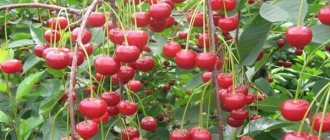Features of Lima beans
Like other legumes, Lima beans are an annual herbaceous plant. It can be bushy or climbing:
- Bush varieties form compact plants that do not require care. After seed germination, the crop begins to ripen in 65-80 days.
- Climbing varieties form long vines. Caring for such plants is complicated by the need to create support. These plants require regular irrigation and frequent feeding. The harvest ripens 80-90 days after the sprouts appear. These varieties produce more fruit than bush varieties.
Lima beans are characterized by bluish-green coloring of densely growing leaves. During flowering, the plants are covered with inflorescences of white, greenish or lilac flowers. The buds do not bloom together. One plant can have both flowers and already formed fruits.
Unlike other varieties of beans, lima beans produce short, wide and flat beans up to 18 cm long. From 2 to 4 seeds are formed inside. When fully ripe, they have a greyish, white or creamy skin tone. What it is and what the seeds look like can be seen in the photo.
As the bean ripens, a thick parchment layer forms inside the bean. Therefore, such pods as a whole are not suitable for food, but they are eaten green.
Existing varieties of lima beans are divided into 2 groups. The first includes plants with large seeds up to 4 cm in size. Others have smaller seeds. These beans are called baby lima beans.
A transitional variety is the Sweet Bean lima bean. Its bushes reach 1.5 m in height. Therefore, when growing this variety, support is used. During fruiting, wide beans up to 12 cm long are formed on the plant, containing from 3 to 5 grains of a greenish tint inside. They ripen 80 days after the sprouts appear. The fruits have a sweetish taste due to their high sugar content, boil quickly and give a long feeling of fullness.
On a note!
Lima beans are valuable not only for their delicious, buttery, creamy fruits. The plant is useful to grow on the site as a fertilizer to enrich the soil with nitrogen beneficial to plants.
Description of the plant and its history
Lima beans are native to Central America. The oldest seeds of this species were found in layers that are more than 5,000 years old. Lima beans were cultivated by the ancient Incas; they came to Europe after the Spanish conquests in the 16th century, and began to be used in cooking in the 18th century. Many novice gardeners are interested in lima beans - what they are, how to grow them in their summer cottage. To properly cultivate a hybrid, it is best to seek help from experienced farmers.
This vegetable has the following description:
- is an annual plant that is grown in 3 types: a shrub, a type with creeping branches or a climbing part;
- the variety is self-pollinating, although if there is an apiary nearby, the farmer can attract bees to fertilize the beans;
- the height of the bush ranges from 0.3 to 1.8-2 m (for climbing types), and for creeping species this figure reaches 15 m;
- racemose inflorescences contain from 25 to 30 purple or white-green flowers standing on short stalks;
- The opening of the buds occurs gradually.
The yield of all subspecies of this crop is quite high. The weight of 1000 grains, depending on the variety, ranges from 0.25 to 1.5 kg.
Beneficial features
Lima beans contain a whole range of valuable substances. The greatest benefit to the body comes from eating fruits that have not reached final maturity. Young grains in a state of milky ripeness are pleasant to the taste and easily digestible.
The protein content of lima beans ranges from 18 to 25%. It is absorbed almost completely and can become a complete replacement for animal protein for vegetarians. Lima beans are rich in fiber. This is the second most important element contained in this product. Dietary fiber gives a feeling of fullness without adding extra calories, rids the body of toxins, and normalizes the amount of sugar in the blood.
Lima beans contain sufficient quantities of molybdenum, magnesium, manganese and potassium. All these elements are important for the normal functioning of the heart muscle. They maintain normal cholesterol levels. Lima beans contain a lot of iron, which is involved in the synthesis of hemoglobin. It is necessary to provide cells and tissues with oxygen. Lima beans also contain sufficient quantities of B vitamins, folic acid, tocopherol and other macro- and microelements.
Useful properties of lima beans:
- normalizes blood sugar concentration;
- cleanses blood vessels from harmful cholesterol;
- normalizes digestion;
- relieves constipation;
- prevents the development of oncology;
- cleanses the body of toxins, removes toxins;
- improves the functioning of blood vessels and heart muscle.
Lima beans are a very healthy product, but if you are prone to flatulence, you should use it with caution. When overeating, it causes increased gas formation. Patients with diabetes and urolithiasis should also use this product with caution.
Composition of the product
Nutritional value 100 g:
- Calories 106 kcal
- Proteins 4 g
- Fat 4 g
- Carbohydrates 8 g
- Dietary fiber 5 g
- Water 05 g
Why doesn't the rabbit eat or drink? Lack of appetite in rabbits: what to do? The rabbit doesn't eat all day.
This product contains a small amount of calories due to its predominantly water content. Fiber (dietary fiber) also reduces the calorie content of beans. The protein contained in the fruits is close to the complete composition of amino acids. Vegetable fats are considered more beneficial than animal fats and reduce the risk of developing atherosclerosis.
Lima beans are rich in vitamins: folic acid, B1 and B6, C and K.
The function of these compounds in the body:
- participation in hematopoiesis;
- improving the functioning of the nervous system;
- normalization of the heart and blood vessels;
- maintaining healthy skin and hair.
Microelements in lima beans:
- magnesium is an important micronutrient for the heart and muscle tone
- manganese – necessary for the synthesis of certain hormones;
- phosphorus – helps strengthen bones;
- iron - is part of hemoglobin and myoglobin, as well as some other important enzymes that ensure the exchange of oxygen in the body.
Interesting! Lima bean flour is used in cosmetology to prepare nourishing masks that refresh the skin of the face, neck, and hands. Their application improves complexion, is an excellent rejuvenating procedure, and combats dry skin, especially in winter.
How to Grow Lima Beans
Lima beans are native to countries with a subtropical climate. Therefore, it feels good at high air temperatures. For good plant development, the air must warm up from +18 degrees and above. In this case, the temperature should not be higher than +30 degrees, so that the number of ovaries does not decrease. Extreme heat makes the plant's pollen sterile.
Important!
Favorable climate conditions for growing Lima beans in open ground are created only in regions with a mild southern climate. In the middle zone, this plant is grown only under film covers. Young plants are especially susceptible to temperature fluctuations.
If you plan to plant plants in open ground, select a well-lit area that is completely protected from the cold wind. It is important to take into account predecessors. It is better to choose places where pumpkin or nightshade crops used to grow.
Preparing the bed for planting is as follows:
- In the fall, the area under the garden bed is dug up, simultaneously adding 40 g of superphosphate per square meter of area.
- If the soil is too acidic, liming is carried out.
- In the spring, the bed is loosened and mineral complexes are added at the rate of 30 g per 1 square meter. m. area.
Sowing of seeds is carried out only after the final warming, when there is no threat of frost. In this case, the soil should be well warmed up to a temperature of +15 degrees at a depth of 10 cm. Usually the time suitable for sowing seeds occurs in the last days of May.
Seeds are placed using the square-nest method at a distance of 40 cm from each other. When arranged in a row, the distance between plants in a row is reduced to 10 cm. The interval between individual rows is left 40 cm. Until the air temperature reaches +18 degrees at night, the plantings are covered with film, securing it to the installed arches.
The agricultural technology of lima beans is no different from the cultivation of traditional legumes. The plant needs regular irrigation. It is especially important to frequently water the bushes during flowering, formation and ripening of fruits. In this case, the soil should not be flooded. Excess moisture is detrimental to the root system of beans.
Important!
For climbing varieties, a support must be built. It is necessary so that the lashes on the ground do not create a thickening of plantings and do not provoke the development of fungus.
Between waterings, the soil between the rows is loosened to a shallow depth. Be sure to remove all weeds. Periodically, the beans are fed by adding ammonium nitrate and superphosphate at 10 g per 1 square meter. m. landing.
Growing and caring for crops
Since the crop comes from warm, sunny regions, to grow it you need to choose a sunny area where there are no draft winds and stagnant moisture. Lima beans can be grown by sowing seeds in a garden bed or using seedlings.
Sowing in the ground
You need to start preparing the soil in the fall - dig it up, remove plant debris, weed roots, add 40 g of superphosphate per 1 m² and, if necessary, lime (350-500 g per 1 m²). In spring, spread granules of complex fertilizer (40 g per 1 m²) on the ridge and harrow it.
It is necessary to start planting when the soil warms up to 15 °C. The timing depends on weather conditions. If planted in cold soil, the seeds may simply rot while waiting for warmer weather. The seed material must first be disinfected by soaking it in a pink manganese solution for three hours.
- holes (depth 3.5-6 cm) for bush varieties are placed at intervals of 20 cm, row spacing - from 40 to 60 cm;
- for climbing varieties, the distance between holes is greater - approximately 30 cm, row spacing - from 80 to 90 cm;
- can be planted in a square-cluster method, leaving an interval of 50 to 70 cm between seeds;
- immediately install supports; if this is not possible, plant beans or corn near the fence.
To protect from unstable spring weather, it is recommended to build a shelter from film or covering material on top.
Planting seedlings
You should start preparing seeds for planting in early March - after processing, spread them on a damp cloth and leave until they swell (keep the cloth damp, but not wet). After the roots appear, plant them in cups with a disinfected soil mixture consisting of garden soil, peat, and sand.
If the soil is fertile, then fertilizing is not necessary, and if fertilizer is required, then superphosphate is used after the shoots appear. Water regularly, keeping the soil moist. Try to avoid excessive moisture so as not to damage the root system. When constant daytime temperatures are established at 16°-20°C, seedlings are planted on a ridge.
Further care will consist of the usual procedures of watering, loosening, hilling, and fertilizing:
- water early in the morning or in the evening when the top layer of soil dries, not allowing water to stand under the bushes;
- when watering, try not to get it on the leaves - a drop of water in the sun becomes a lens and can cause a burn;
- in inclement rainy weather with a lot of precipitation on heavy soils, you can build a film shelter over the plantings to prevent the beans from getting wet;
- The first fertilizing should be carried out no earlier than two weeks after transplanting the seedlings into the ground - an infusion of greens (chop nettles, weeds, add water and leave for at least a day) mixed with a small amount of sifted ash, diluted with water in a ratio of 1:8, pour 1 liter under the bush ;
- for the following fertilizing (there should be at least three in total), you can use solutions of ammonium nitrate or phosphate fertilizers according to the instructions, combining them with the addition of an ash solution (mix equal parts of ash and water, then dilute with water 1:10);
- carry out surface loosening and hilling of bushes several times a season - when watering, the lower part of the stems is exposed.
Pests and diseases
Compared to other varieties of beans, lima beans are less susceptible to disease. It resists viral and bacterial diseases especially well. In July and August, bushes can become infected with downy or true powdery mildew and spotting. Against these diseases, plants are treated with the drug “Baktofit”. Spraying with a solution of copper sulfate or Bordeaux mixture at a concentration of 1% also helps.
Lima beans are not affected by bean weevil. But foliage and succulent shoots attract aphids, spider mites and thrips. The foliage is often infested by caterpillars. To rid plants of harmful insects, before the time of flowering, the bushes are treated with the drug "Aktara". When the flowers fall off, the plants are sprayed with Gaupsin.
To protect the plantings from aphid invasion, potatoes and tomatoes are planted around the beds. These plants attract ladybugs, which eat these pests. Medicines containing tobacco also work well against them.
Important!
Infusions made from onions or rose hips are suitable for combating grains. If pests remain after such treatment, the bushes are sprayed with special biological agents.
Harvest and storage
The timing of bean ripening is influenced by the plant variety. On average, the first beans begin to be picked 14 weeks after germination. Bush varieties ripen earlier; climbing varieties do not reach maturity immediately. Then the beans are collected in several stages.
If the beans are intended to be consumed whole or frozen for the winter, the pods are picked before they reach milky ripeness. These beans have delicate skin and juicy pulp. Fresh pods can be stored in the refrigerator for two weeks or frozen in the freezer after first blanching and drying. Sometimes the harvested legume crop is canned.
Fully ripened beans are shelled, the seeds are placed in sealed containers with lids and stored in this form for 4-5 months. The jars are left in a cool, dry place. If stored improperly, beans lose their beneficial properties and become tasteless.
Stewed beans with mushrooms. Ingredients
Another interesting recipe. This time, any bean can be used. It is preferable to choose the Lima variety, because when cooked correctly it literally melts in your mouth. To experience the taste of a new dish, buy the following products:
- forest mushrooms (frozen) – one kilogram;
- beans – 300 grams;
- red tomatoes - three pieces;
- garlic - four cloves;
- fresh parsley - one bunch;
- marjoram (dry) – one teaspoon;
- salt, pepper - to taste;
- basil - one tablespoon (tablespoon).
Recipes
Lima beans are suitable for preparing a variety of dishes. On average, boiling beans takes 45 minutes. To reduce the time spent on cooking, no salt or spices are added during the cooking process.
Lima bean curry
This dish requires additional unusual ingredients. You can buy them in stores selling Indian goods or healthy food products.
Ingredients:
- 400 g lima beans;
- 3 medium onions;
- 10 pieces. sun-dried tomatoes;
- 400 ml coconut milk;
- 3 medium chopped tomatoes;
- 400 ml water;
- 2 tbsp. l. olive oil;
- 1 tbsp. l. curry;
- 20 g fresh cilantro;
- salt and chili pepper to taste.
How to cook:
The beans are boiled. While it is cooking, peel the onion, cut into small cubes and fry in oil for 5 minutes, adding spices. After this, add chopped tomato and a little water. The dish is simmered, stirring all the time, for another 5 minutes. Then add coconut milk and heat the dish. Finish cooking by adding beans and sun-dried tomatoes. Keep the dish on the fire for another 2 minutes and turn it off. When serving, plates are decorated with cilantro.
Lima beans stewed with mushrooms
In addition to lima beans, other types of legumes are suitable for this dish. But the dish tastes best with lima beans.
Ingredients:
- 500 g frozen mushrooms (it is better to take forest mushrooms);
- 150 g Lima beans;
- 2 small tomatoes;
- 2 cloves of garlic;
- 10 g fresh parsley;
- 0.5 tsp. marjoram;
- 1 tsp. basil herbs;
- pepper and salt to taste.
How to cook:
The beans are soaked for 4 hours. Then add fresh cold water and bring to a boil. Place parsley and garlic into the pan. Cook everything together for 40 minutes. Then add the tomato cut into small pieces. Cook everything together for another 60 minutes.
Separately, in a frying pan with high sides, mushrooms with garlic and spices are fried in oil. After 7 minutes, add the remaining tomato, cut into small pieces.
Remove the remaining tomato, parsley and garlic from the pan. The beans and liquid are added to the mushrooms and simmered together for another quarter of an hour. Before serving, sprinkle the finished dish with finely chopped herbs.
Secrets of heat treatment
The vegetable came to us from America. Europeans became acquainted with it in the 16th century, after visiting Peru. Now it is cultivated in many countries: China, India, Burma. The beans got their name in honor of the Peruvian city of Lima. Because of its half-month shape, many people call it moon-shaped.
Caring housewives know the secrets of preparing this wonderful product. Some of them are outlined below:
- Lima beans take a long time to cook. To speed up this process, it is pre-soaked. After this, it is put on fire for two minutes. Next, remove the product from the stove, cover with a lid and set aside for two hours. An alternative option is to cover the vegetable with water and refrigerate for six to eight hours. Before heat treatment, the liquid is drained and washed under the tap.
- After this, water or broth is added to the beans. Bring it to a boil, reduce the heat and cook, almost completely covering the pan with a lid. When cooking, a lot of foam is released. It must be removed regularly with a spoon. Therefore, a pressure cooker is not used for cooking. Cooking time is about 45 minutes.
- It is important to remember that lima beans do not tolerate the addition of salt or seasonings throughout the cooking process. For example, lemon juice is contraindicated for her. This makes the product hard. The processing time increases. It is better to add additional components at the very end of boiling.
Reviews
Maria, 53 years old
This was my first time growing lima beans from seedlings. I didn’t dare plant it directly into the ground, since the plant is heat-loving. After transplanting into open ground, the seedlings began to develop only after the onset of warm weather. Otherwise there were no difficulties with cultivation.
Elena, 48 years old
Lima beans are no more difficult than regular beans to grow on site. It is unpretentious and produces good yields. The grains are tasty, sweetish, with a taste of butter.
Care features
In order for the bushes to take root well in the spring, you must first carry out the following work:
- In the fall, the soil on the site is prepared. It is dug up, weeds are removed, and phosphorus and potassium mixtures are introduced into the soil.
- This procedure is repeated in the spring. Wood ash is added to the ground.
- The soil for planting is selected without stagnant water and with neutral acidity. The place for bean seedlings should be well lit by the sun.
- The bushes are fed for the first time 14 days after transplantation. An infusion is prepared from ash and green shoots. To do this, cut the nettles, add hot water, leave for 24 hours. Then mix with ash flour, dilute with water in a ratio of 1:8. For each bush, 1 liter of mixture is enough.
After transplanting Lima bean seedlings or when growing seedlings on site, carefully mound the soil around them. The bushes need to be supported to protect them from strong gusts of wind, otherwise the tender shoots will die.
Important! If it is not possible to make a support, the seedlings are placed close to the fence.
The predecessors of beans can be tomatoes, zucchini, potatoes, and pumpkin. You cannot plant beans in soil where cruciferous crops, such as radishes and turnips, previously grew.











